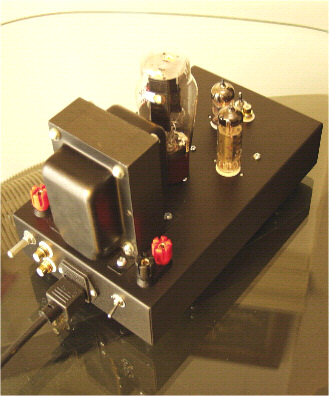|
THE EX MODS Aug 2004 by Steve Deckert
A re-occurring topic that still seems to be misunderstood is the Zen EXTREME mod's that I've mentioned in several places. This paper will describe exactly what they are in a way that makes sense so you can know if you should pursue them or not. The EX modifications are specific to only two of our amplifiers. These are the SE84C and or SE84CS. The modification involves changing the output transformers from a 9800 ohm primary impedance to a 3300 ohm primary impedance. What does that do? Well, in short, it re-focuses the amplifiers performance from low impedance loudspeakers to very high impedance loudspeakers. Please read on! As many of you know these amplifiers in their stock form were designed to drive very difficult loads all the way down to an almost short circuit if need be. For example, you could hook several speakers in parallel to one of these amps bringing the total speaker load down to around 1/2 ohm and the amp will actually LIKE it! For sure it is the ONLY SET (Single Ended Triode) amplifier in the world that can do this! It is also THE reason why these little 2 watt amplifiers kick-ass the way they do! THERE IS A REASON why I designed the amps to handle such low impedances! With few exceptions, most loudspeakers today carry a nominal impedance rating of 6 or 8 ohms. However, many people do not realize that "impedance" is a combination of "resistance", "inductance" and "capacitance". They also do not realize that when a speaker claims to be 8 ohms that it really is NOT. A speaker will present a different impedance to an amplifier at every frequency it plays. This phenomenon is greatly effected by the cabinet design, ie., cabinet size and tuning frequency. This impedance typically will go up and down across the frequency spectrum. On an typical 8 ohm loudspeaker it will usually drop in places down to around 4 ohms and can rise as high as 50 ohms or more in other places. In fact the popularity of many of the great sounding loudspeakers of the last 20 years was offset by the fact that very few amplifiers could properly drive them. Reason? They had dips in the impedance curve that dropped all the way down to 2 ohms. Most amplifiers, especially solid state, went into cardiac arrest when used on these speakers. I designed the SE84C and CS amplifiers to cope with this reality. This has lead to a common assumption that you need low impedance speakers to have the "best match" with these amps. This is not true. The SE84C and CS amplifiers are designed to work well with conventional speakers rated at 4, 6 or 8 ohms. Occasionally you run into a speaker that is rated at 8 ohms, and actually presents a load to the amplifier between 6 and 50 ohms. This would be like our Fostex single driver crossoverless speaker, Lowthers, and similar crossoverless speakers. Of course there are also many speakers with a 16 ohm rating that present the amp with loads that seldom drop lower then 10 or 12 ohms. It is these type of speakers that motivated the EX mods. Why? Because in a stock SE84C or CS amplifier the power tends to drop as the impedance rises. That means that it's 2 watts of power may drop to 1 watt or less when coupled to these high impedance loudspeakers. While many of our customers use these amps with these speakers and think it sounds just fine, it is only because the speakers just happen to also be very high efficiency. High enough to where a 1/2 watt of power is plenty. I created the EX mod specifically for HIGH IMPEDANCE speakers which include 8 ohm single driver speakers with no crossovers, and or conventional 16 ohm speakers. The reason behind the mod was to get more TONE and WEIGHT to the music... a more complimentary signature if you will. So, if you've read about the EX mod's on forums and own conventional 8 ohm speakers with crossovers, the mod is not for you because your speakers most likely have dips in the impedance that fall around 4 ohms. IF you have a conventional speaker that claims to have a very "easy to drive" flat impedance curve with minimal dips and peaks in it, you can be certain that the speaker has a COMPLEX crossover network with Zobel impedance networks in it. Complex crossovers and SET amplifiers are generally a poor combination because complex crossovers spend much of the first watt or two as heat making them too inefficient to work right with low power amplifiers.
Decware is a trademark of High Fidelity Engineering
Co. |
 With
our online forums it is not hard to get a little confused or miss-guided
by the simple fact that there is so much information there.
With
our online forums it is not hard to get a little confused or miss-guided
by the simple fact that there is so much information there.